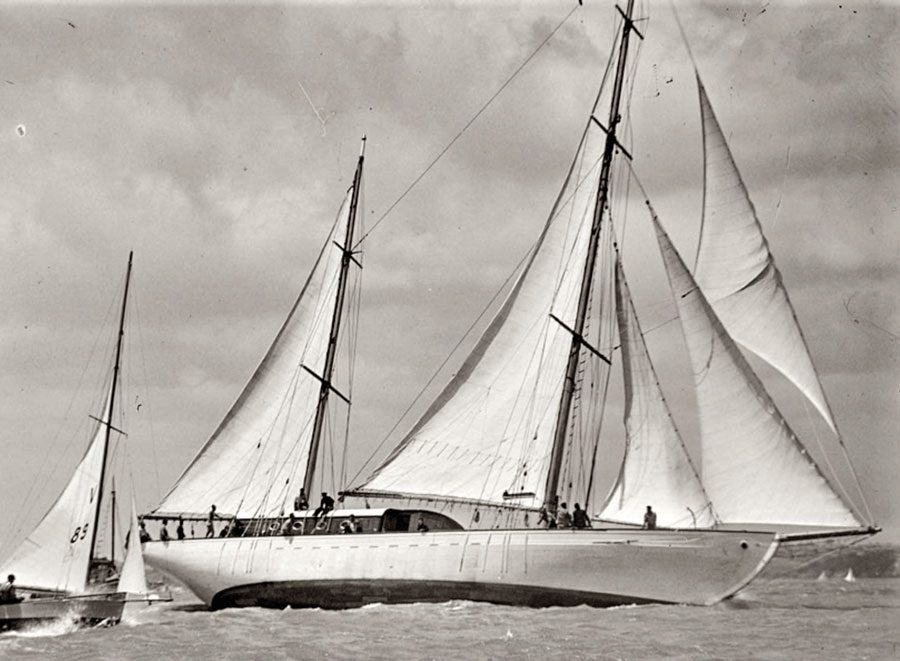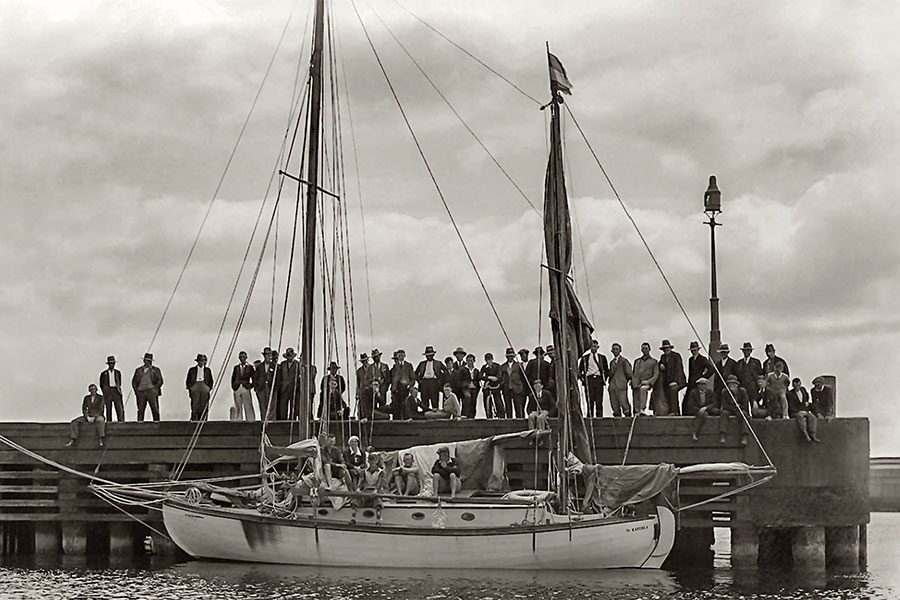

John Dallimore of Whitianga has recently gifted the 24ft mullet boat Maru to Jason Prew, classicyachtsman- about-town, on the condition that Jason restores her.
Jason is prominent as a member of the Classic Yacht Association and as Slipmaster of ‘The Slipway Milford’, the yacht and launch repairers in Milford Creek in the premises once run by the late John Gladden and recently by Geoff Bagnall. Jason has owned the keel yacht Loloma (1908) and more recently totally restored the Logan-designed Wairiki (1904) and the W.H. Hand-designed planing launch My Girl (1925).
Maru is a wonderful survivor of the once-strong 24ft mullet boat class which carried the class-letter I for many years on the Waitematā.
 Bill Tupp’s Why Not (I9) mixing it with the 26-footers Omatere (H9) – from a
Bill Tupp’s Why Not (I9) mixing it with the 26-footers Omatere (H9) – from a
watercolour by Bill Tupp.
Perhaps the most famous of these 24-footers were the Charles Collings-designed Glady (1904) and Why Not and Maru (1905). Collings was then in partnership with the Clare brothers, trading as Clare & Collings who were in the forefront of centreboard design and construction.
Charles Collings (1870-1946) served part of his boatbuilding apprenticeship with Robert Logan at Devonport around the time he was building Tawera, Matangi and Akarana. He first came to prominence in Auckland yachting with the patiki Waitekauri he built for the 1898 Intercolonial Yacht Championships on the Waitematā. At the time he was a bridge and house builder at Waitekauri on the Thames goldfields. He then joined the Clare brothers at their yard in St Mary’s Bay to fill the large vacuum left by James Clare who died in October 1902.
With Collings’ advanced designs, Clare & Collings soon became the go-to builders for the craze for racing mullet boats on the Waitematā with a string of landmark yachts starting with the 26-footers Okere and Emerald (1903) and Tere (1904), the 24-footers Tiro (1903) and Glady (1904) and the 22-footer Mowai (1904). In late 1905 Collings launched two crack 24-footers, Why Not for Bill Tupp and Maru for a syndicate headed by carpenters Charlie Arblaster and his cousin T. Mincher of Northcote.
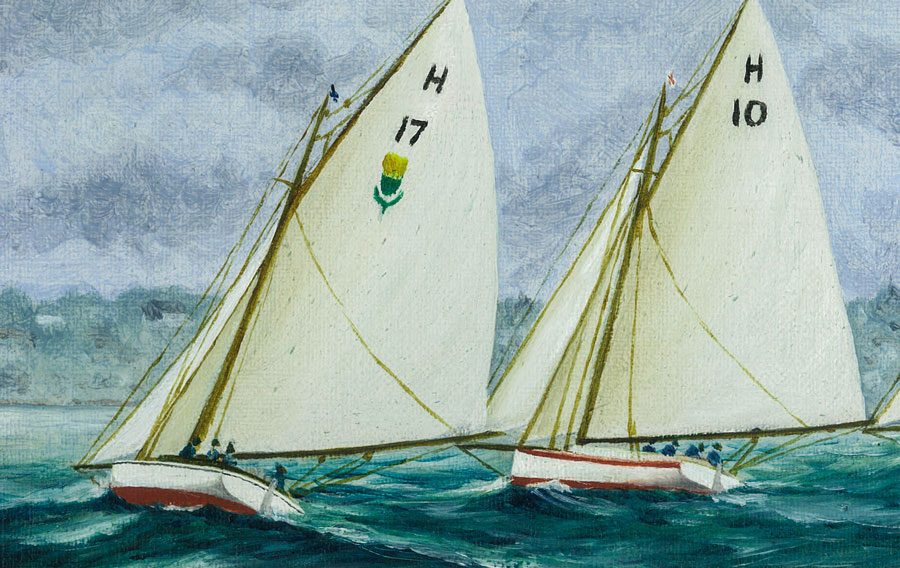 Awatere (H17) and Spray (H10) in the 1920s – from a watercolour by Bill Tupp.
Awatere (H17) and Spray (H10) in the 1920s – from a watercolour by Bill Tupp.
Well sailed by J.H. Mackay of London Street, St Mary’s Bay and later by Arthur Clare, the open cockpit Glady had immediately become the crack Auckland 24-footer, winning the 24-footer championship every year. Why Not was intended to be a clone of Glady, built the previous season for Mackay with a beam of 8ft 9ins, the maximum permissible under the Ponsonby Regatta Regulations. Bill Tupp contracted with Clare & Collings to build Why Not “as near as possible same as Glady”.
Maru, however, was built in a totally different fashion, although the same moulds could have been used. The Regulations called for carvel planking, ribbed on frames with minimum plank thicknesses but Maru was built in the Logan fashion with two skins, the inner diagonal, the outer fore and aft, the only timbers inside being two longitudinal stringers a side, and knees at the centreboard case. Like all Logan diagonal yachts from Jessie Logan of 1880 onwards, when built in heart kauri, the hull would have been lighter, stronger and more durable than the conventional single-skin frame-built equivalent.

Maru, (centre) racing 22-footers Doreen (left) and Mowai (right).
Arblaster and Mincher and other members of the syndicate raced Maru consistently with all the Waitematā yacht clubs then catering for mullet boats as the key members of their fleets, Ponsonby, Richmond, North Shore and Devonport. Typically, in these races, Glady would be scratch boat with Maru on one minute and Why Not on five minutes. At this time, however, the 26-footers were becoming the glamour class and the 24ft class were being lumped in with them during many events. With a reasonable handicap, Maru continued to do well in this company.
In late 1909 19-year-old Harry Gallaugher of Sarsfield Street bought Maru and raced her mainly with his home club Richmond. The 24ft fleet had grown with Charlie Garlick’s Zoe (Bailey & Lowe), Arthur Willetts’ own Waitere, George Lepper’s Ranee (Joe Slattery) and Graydon’s own Lina, for example, while the old-timer Maile , formerly Isca (Robert Logan, 1885) had a new lease of life. However, the tide was still turning away from the 24-footers and would also soon make the 22- and 26-footers pre-eminent. No new 24-footers were built after Fred Mann’s Mistletoe II in 1914. Arblaster and Mincher had the 26-footer Starloch built by Bailey & Tyer at Hall’s Beach in 1913.

OOPS; Maru (left) and Waterwitch entangled after their collision on 27th April 1912.
In early March 1912 Gallaugher challenged F.A. Hunt of Ponsonby, the owner of the 26ft patiki Waterwitch, to a race around the Victoria Cruising Club’s harbour course for £5 a side. Match races of this sort were common and pleased the waterfront punters. Alf Trevarthen had built Waterwitch at Ponsonby in 1906. She was used for racing, cruising and occasionally commercial fishing. Harry sailed Maru but the crack centreboard skipper Jick Rogers, the uncle of Billy Rogers, sailed Waterwitch. It was a fair match but Waterwitch won, not surprisingly.
In 1918 Gallaugher sold Maru to P. Matheson of Ponsonby. She rapidly went through a number of hands. McIvor of Dominion Road had her in 1919 and sold her to McCloskey, Hall and Leahy of Onehunga in March 1920. They painted her blue, fitted her with a cabin top and bunks, fitted a new set of sails and raced her on the Manukau for a season. In November 1921 they sold her to Speight and Gill back on the Waitematā. Frank Lowe of William Street Devonport had her in 1923. For a couple of seasons now she had been racing with the 26-footers with sail number H18 and acquitting herself well in that company. She had also gained a three horsepower, locally made Zealandia auxiliary engine. Lowe appears to have done no racing after the 1923 Anniversary Regatta but preferred to use her for cruising. She no longer bravely wore the racing number H18 but reverted to I2.
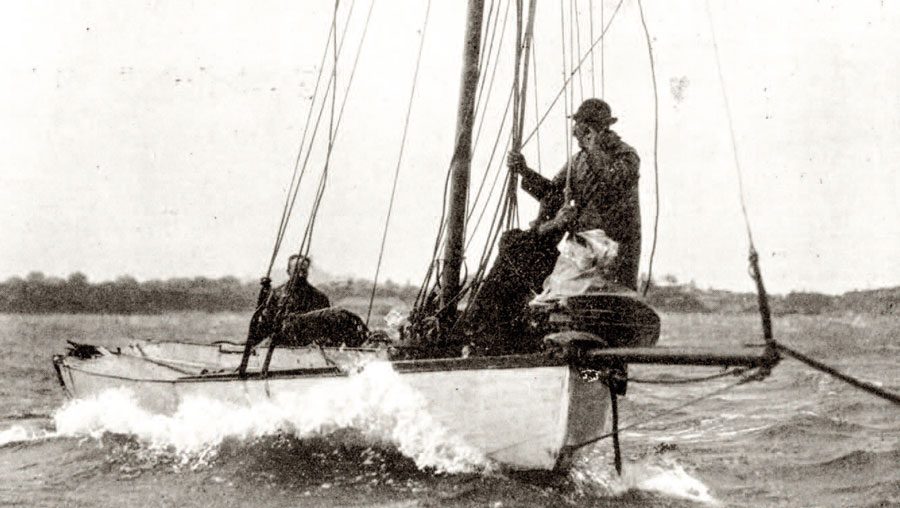
Waterwitch under tow to be beached.
John Grieve of Faulder Ave, Westmere bought Maru in the mid-1930s and kept her moored off Cox’s Creek. He used her mainly for cruising, with an annual cruise north. He raced her occasionally with Ponsonby and Richmond in the mixed H and I class. She was always kept in spanking new order.
John, in Maru, picked me up with the rest of a capsized Sea Scout cutter’s crew, off Birkenhead Wharf around 1950. I was the last aboard, in a pretty bad way with cramp and no lifejacket. My father had insisted I take a Navy ‘Mae West’ jacket but I gave it to a little chap who was crying. As Maru swooped back and forth in the vicious westerly, the crew scooped the boys out of the water one by one in a splendid display of seamanship. I had no doubt John saved my life. My father bought me a bright-yellow japara Hutchwilco lifejacket on the Monday.
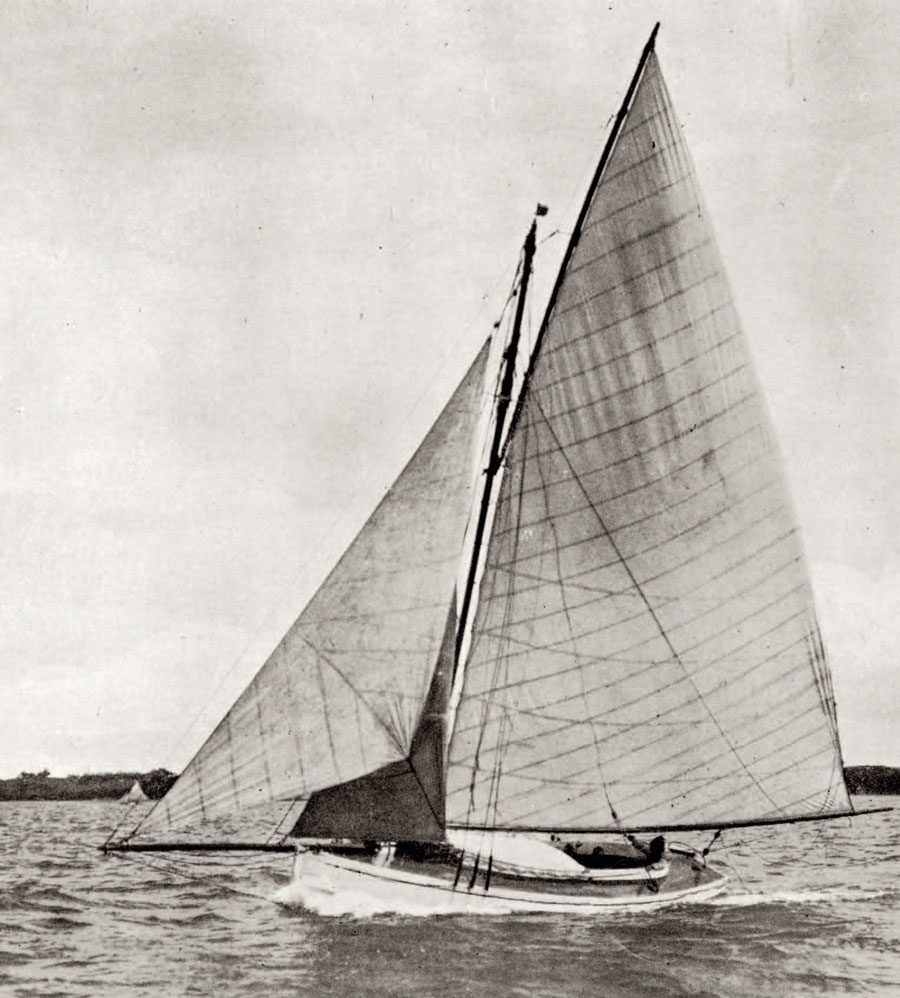
Maru in 1911 showing the canvas cover over the front of the open cockpit.
John Grieve eventually sold Maru. She was reported in Ngunguru around 1975 owned by George Amos, then Bo Boyd of Whitianga but she gained a long-term devoted custodian in John Dallimore of Cooks Beach in the late 1980s. It was John who has just sold Maru to Jason Prew. We expect her to prosper. BNZ

Glady
MULLET BOATS 101
Mullet boats (‘mulletties’) are a purely local type of centreboard smack developed from the late 1870s for netting mullet close to Auckland. They were produced commercially by a handful of builders, tending to a type that was a gaff cutter of about 24ft loa, straight-stemmed with a broad counter stern for laying and retrieving the nets. With a two-man crew, they had to be fast and good to windward in the prevailing westerlies to get the catch of about a ton back to market fresh.
As early as 1885 the type was being built for racing only. In Auckland’s egalitarian society the mullet boat became the yacht for the working man. We had a society then where a working man could indulge in serious yachting, not only racing around the buoys but cruising in the splendid harbour and the Hauraki Gulf in its backyard. The mullet boat ticked all these boxes.
By 1903, when mullet were disappearing anyway under the pressure of fishing and propeller noise, there arose several types of mullet boats racing in classes based on Restrictions put out by the Ponsonby Regatta Committee. These dealt with matters like dimensions, construction, scantlings and ballast. Eventually there were four jealously guarded restricted classes, all of which purposely retained their origins in the working mullet boats. The Committee was highly successful in crystallising these types as wholesome yachting classes for Auckland yachtsmen.
Eventually these classes consisted of 20-, 22-, 24- and 26-footers and they flourished. In 1922, when the Auckland Yacht & Motor Boat Association introduced alpha-numeric numbers for its classes, these classes were allotted the letters N, L, I and H respectively.

